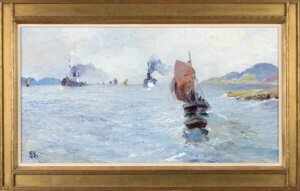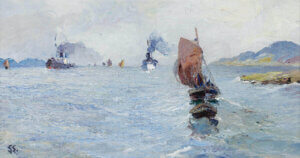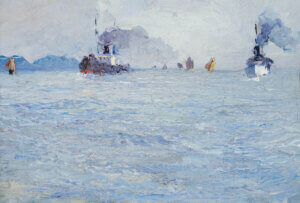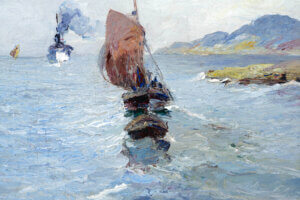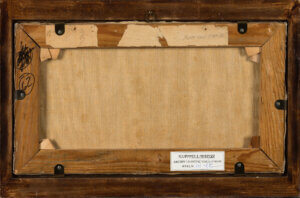Leontine von Littrow is probably the most extraordinary painter of the Austrian Riviera among the many artists of the turn of the century who traveled to the sea and the coasts of the monarchy and documented them in important paintings.
She came from an old aristocratic family. Her father was a cartographer and writer. He was appointed head of the local nautical academy in Trieste, where Leontine von Littrow was born as Camilla Leontine von Littrow. He later became captain of the port of Fiume (Rijeka), the largest port in Hungary at the time.
One of her eleven uncles was the famous astronomer, university professor and director of the Vienna Observatory Carl Ludwig von Littrow, who was married to the writer and women’s rights activist Auguste von Littrow; their daughter was the painter Ella von Littrow, later married to Lang. Leontine grew up in the home of this well-educated family, whose salon was a focal point of intellectual Vienna. Feuchtersleben, Dannhauser, Ebner-Eschenbach, Hebbel, Grillparzer and Ottilie v. Goethe also stayed there.
Leontine received her first painting lessons from Hans Canon, who was a guest at the Littrow house and recognized young Leo’s talent. Leo subsequently met Jean d’Alheim, a Russian baron who worked as a painter in Paris. He inspired the young artist’s further development in her turn to Impressionism, which Leontine von Littrow interpreted in her own unique way with virtuoso strokes in magnificent light and color.
She got to know the area around Trieste and Abbazia (Opatija), where the Littrow family lived, at an early age. She repeatedly chose this landscape as the subject of her paintings. She captured them in numerous city and harbor views, bays and coastal surf studies. Her interest in the Istrian and Dalmatian landscape brought her together with Olga Wisinger-Florian (1844-1926), with whom she shared both artistic interests and a close personal friendship. The two painters met in 1887 when OWF was working as a teacher in Abbazia. That very summer, they undertook a trip to Ragusa (Dubrovnik) in Dalmatia together with Emil Jakob Schindler (1842-1892).
To be recognized as a painter before the turn of the century was difficult for women. However, there are already some indications of her esteem at the time; not only recurring exhibitions in Vienna, Munich and above all London; but when commissions were awarded for the decoration of the Hochparterresäle in the Natural History Museum with paintings in the years 1883-86, Leontine von Littrow was the only female painter who was not passed over. The paintings depict the coast of Ragusa.
Leontine von Littrow was a member of the Vereinigung Bildender Künstlerinnen Österreichs and participated in various annual exhibitions at the Vienna Künstlerhaus and in exhibitions of the Vereinigung bildender Künstlerinnen Österreichs – of which Littrow was also a member – as well as taking part in the international annual exhibition at the Glaspalast in Munich in 1893.
